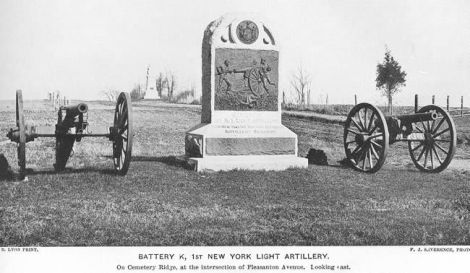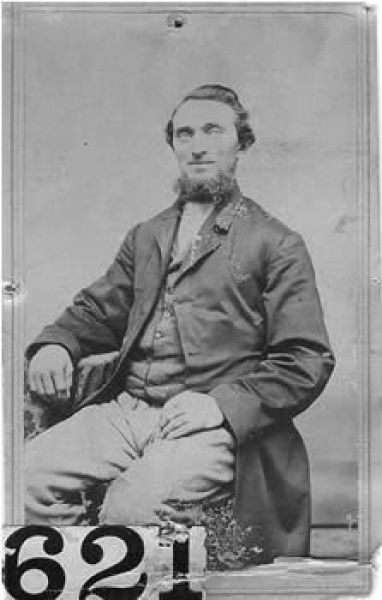Battery K, 1st Artillery Regiment (Light)
Mustered in: November 20,1861
Mustered out: June 20,1865
THE FOLLOWING IS TAKEN FROM NEW YORK IN THE WAR OF THE REBELLION, 1ST ED. FREDERICK PHISTERER. ALBANY: J. B. LYON COMPANY, 1912.
Battery K — Fort Plain Battery — Capt. Lorenzo Crounse, recruited principally at Fort Plain, Stockbridge, Jasper, Elmira and Canandaigua, was mustered in the United States service November 20, 1861, at Albany, and December 15, 1861, its surplus men were transferred to the other batteries of the regiment. It served at and near Washington, D. C., from November, 1861; in the Military District of Washington from April, 1862; at Harper's Ferry, W. Va., and in the 2d Brigade, Sigel's Division, Department of Shenandoah, from May 27, 1862; in the 2d Division, 2d Corps, Army of Virginia, from June 26, 1862; in the 2d Division, I2th Corps, Army of the Potomac, from September, 1862; in the 1st Division, 12th Corps, from October, 1862; in the Department of Washington from February, 1863; in the 1st Division, I2th Corps, Army of Potomac, from April, 1863; in the Artillery Reserve, Army of Potomac, from May 12, 1863; in the 4th, and later in the 3d, Volunteer Brigade, Reserve Artillery, Army of Potomac, from May, 1863; in the Artillery Reserve, Army of Potomac, from July, 1863; in the 3d Volunteer Brigade, Artillery Reserve, Army of Potomac, from October, 1863; in the 1st Brigade, Artillery Reserve, Army of Potomac, from March, 1864; and in the defenses of Washington, 22d Corps, from March, 1864. Commanded by Capt. Solon Walter Stocking, the battery was honorably discharged and mustered out, June 20, 1865, at Elmira.
THE FOLLOWING IS TAKEN FROM THE UNION ARMY: A HISTORY OF MILITARY AFFAIRS IN THE LOYAL STATES, 1861-65 -- RECORDS OF THE REGIMENTS IN THE UNION ARMY -- CYCLOPEDIA OF BATTLES -- MEMOIRS OF COMMANDERS AND SOLDIERS, VOLUME II: NEW YORK, MARYLAND, WEST VIRGINIA AND OHIO. MADISON, WI: FEDERAL PUB. CO., 1908.
Battery K ("Fort Plain Battery"), Capt. Lorenzo Crounze, recruited at Fort Plain, Stockbridge, Jasper, Elmira and Canandaigua, was mustered into the U. S. service on Nov. 20, and Dec. 15. 1861, its surplus men being transferred to the other batteries of the regiment. Capt. Crounse resigned on Sept. 9, 1862, and Capt. Robert H. Fitzhugh succeeded to the command. When the latter was promoted major, on Sept. 7, 1863, Capt. Solon W. Stocking assumed the command. It took part in Gen. Pope's Virginia campaign in the summer of 1862, being engaged at Rappahannock River, Beverly ford and the second Bull Run. Attached to the 1st division, 12th corps it participated in the battle of Chancellorsville, and as part of the artillery reserve. Army of the Potomac, in the battle of Gettysburg and the Mine Run campaign. During the 1st year of the war it was stationed in the defenses of Washington with the 22nd corps, and was mustered out at Elmira, June 20, 1865. Its losses were 2 men killed and 15 who died of disease, etc.
The following is taken from Final Report on the Battlefield of Gettysburg (New York at Gettysburg) by the New York Monuments Commission for the Battlefields of Gettysburg and Chattanooga. Albany, NY: J.B. Lyon Company, 1902.
HISTORICAL SKETCH
This battery was recruited at Fort Plain, Montgomery County, and for awhile was known as the " Fort Plain Battery." Recruits were also received from Canandaigua, and from Jasper, a village in Steuben County. The company rendezvoused at the Albany Barracks, and upon the organization of the First Regiment, New York Light Artillery, it joined that command, receiving the designation of Battery K. Lorenzo Crounse was commissioned captain, and the company was mustered into the United States service, November 20, 1861, at Albany. Leaving the State in November it proceeded to Washington where it went into a camp of instruction near the Capitol, remaining there until spring, when it was ordered to the front. It proceeded to Harper's Ferry, Va., in April, 1862, and was actively engaged in the Shenandoah campaign of that spring.
The battery was assigned to Banks' Corps of General Pope's army, with which it participated in the battle of Cedar Mountain, August 9, 1862. Banks' Corps became the Twelfth Corps of the Army of the Potomac, and Battery K was assigned to Williams' (First) Division. Captain Crounse resigned September 9, 1862, and Lieut. Robert H. Fitzhugh was commissioned by Governor Morgan to fill the vacancy. The armament of the battery at this time consisted of four threes-inch rifled cannon.
On April 29, 1863, the Twelfth Corps, with its artillery, left the camps at Stafford Court House, and started for the field of Chancellorsville. Captain Fitzhugh was in command of the Artillery Brigade belonging to Williams' Division, leaving Battery K under the immediate command of Lieut. Edward L. Bailey. Under his direction the four guns did good service from their position near the Chancellorsville House. Captain Fitzhugh, in his official report, speaks of Lieutenants Bailey and Davis as deserving great credit for their gallant bearing under a severe fire, and the excellent judgment displayed by them in the management of their respective sections. He also makes favorable mention of the good conduct displayed by Sergeants Keller, Duane, and Mosher, and Corporals Pitts, Fairbanks, Evans, and Miller. In this battle the battery sustained a loss of seven men wounded.
At the battle of Gettysburg the battery was in the Reserve Artillery of the Army of the Potomac, in the Fourth Brigade, which was commanded by Captain Fitzhugh. Prior to the battle, the men of the Eleventh New York Independent Battery were attached temporarily to Battery K, and two more guns — three-inch rifles — were added to the equipment. During the first two days of the battle the men were not actively engaged, but on the third" day the battery went into position, with the horses on the gallop, at the angle in Hancock's line, where the guns did good service in assisting to repel Pickett's charge. Seven men were wounded during the battle.
The important services rendered by Battery K at Gettysburg are well described in the official report of Captain Fitzhugh, from which the following extract is made:
" Arriving on the field from Taneytown about 8 A. M., July second, I was ordered to take two batteries (K, First New York Artillery, and A, First New Jersey Artillery) and go into position on the Baltimore turnpike, near General Slocum's line.
" The two batteries left with me remained unengaged until 1 P. M., of Friday, July third, when by order of General Hunt, I put them in position near the stone fence in front of General Webb's division of the Second Corps, Battery A, First New Jersey Artillery, on the left of K, First New York Artillery.
" At this time the enemy were making a strong effort to break the Second Corps line, their infantry having charged up to the stone fence near a small wooded knoll about 75 yards on my right, while their artillery fire swept the ground occupied by the two batteries. Just then there were no other batteries at that point and there seemed to be a good deal of confusion. The rebel artillery fire, from near a house and barn about 1,000 yards on my left and front, was especially severe, but soon materially slackened, and became very wild under a fire of percussion and time shell from Battery K. In the meantime, Lieutenant Parsons poured about forty rounds of shrapnel into the flank of the rebel infantry charging the Second Corps, and in about half or three-quarters of an hour the enemy abandoned the attack on that point altogether.
" After a pause of about an hour, the rebel infantry began forming on the right of the house and barn before spoken of, while from the same quarter their artillery opened upon us a brisk but poorly directed and inefficient fire, to which, by direction of General Hunt, I made no reply, but awaited the attack of their infantry, who soon charged over the open field toward some broken ground about 500 yards on my left, as they did so giving the two batteries an opportunity to pour in an enfilading fire, which they did with great effect, for the enemy did not reach the point, but broke and gave way in all directions when about the middle of the field.
" After this we remained in position on the same ground until about 10 A. M., July fifth, when I was ordered to join the Artillery Reserve. Of the conduct of officers and men, I cannot speak too highly. Coming into position at a crtitical point of the rebel charge on our centre, and under a galling fire, the guns were worked with great deliberation and a most decided effect. Casualties in Battery K: Wounded, 7; loss in horses, 5. Ammunition expended: Percussion shell, 57; shrapnel, 15; and time shell, 17; total, 89."
Captain Fitzhugh was promoted to be major of the First Artillery, September 7, 1863, and Solon W. Stocking succeeded to the captaincy. After serving in the Army of the Potomac until March, 1864, Battery K was stationed in the defences of Washington, where it formed part of the Twenty-second Corps. It remained there until the close of the war. It was mustered out of service June 20, 1865, at Elmira, N. Y.




